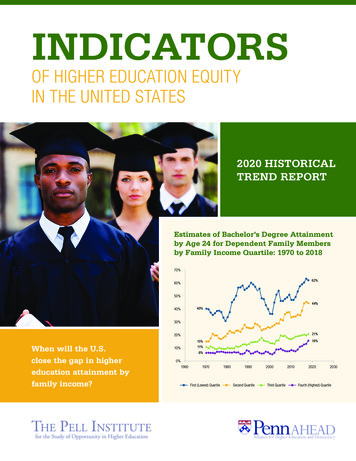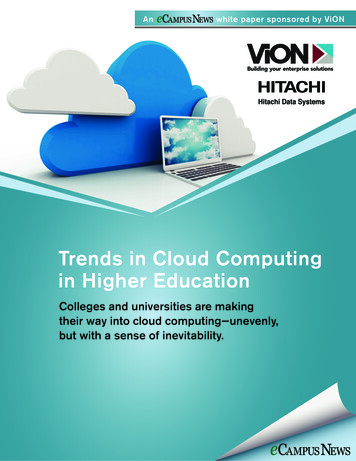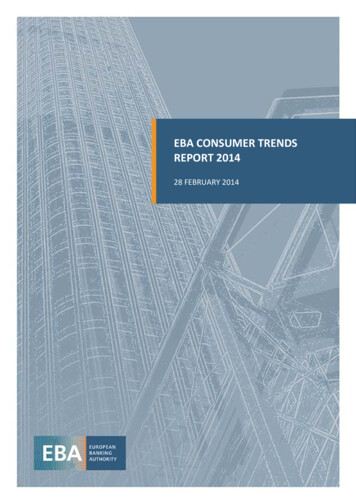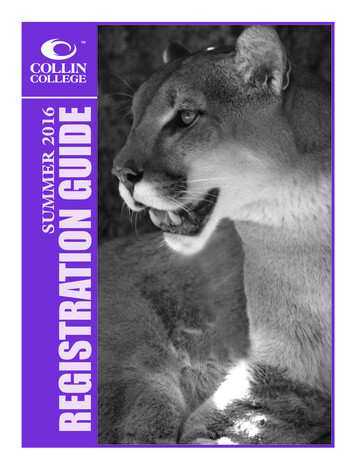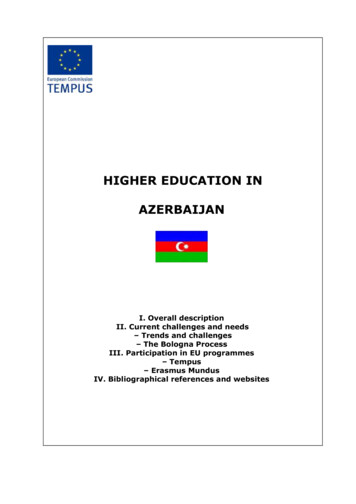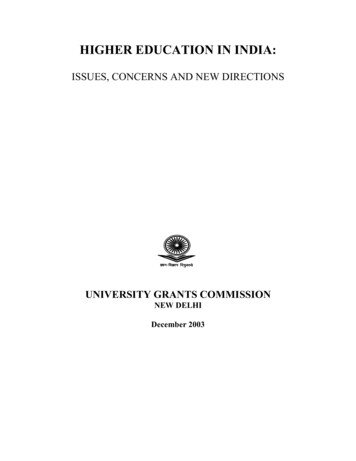
Transcription
2016 TRENDS IN HIGHEREDUCATION MARKETING,ENROLLMENT, ANDTECHNOLOGYNovember 2015In the following report, Hanover Research explores a variety oftrends that have developed in higher education marketing andbranding, as well as in student recruitment, enrollment, andadvancement. A close examination of how technology willimpact higher education in the future is also discussed.www.hanoverresearch.com
Hanover Research November 2015TABLE OF CONTENTSExecutive Summary and Key Findings . 3KEY FINDINGS .4Section I: Branding and Marketing . 6OVERALL TRENDS .6BRANDING AND MARKETING STRATEGY .9MARKETING AUTOMATION .10SOCIAL AND DIGITAL .12Institutional Websites .13Mobile .14Social Media .15Section II: The Student Life Cycle . 17RECRUITMENT .19International Recruitment .20Adult Learners.21ENROLLMENT .22ADVANCEMENT.24Alumni Engagement.25Donor Engagement .26Section III: Technology and Higher Education . 29ONLINE LEARNING .29CHANGING METHODS OF DELIVERY.30Gamification.30Flipped Classrooms .31Adaptive Learning .33Summary of Findings . 35 2015 Hanover Research2
Hanover Research November 2015EXECUTIVE SUMMARY AND KEY FINDINGSIn recent years, the higher education landscape has become increasingly competitive, asuniversities and colleges strive to recruit and retain high-quality students. According to a2015 Inside Higher Ed and Gallup survey of admissions directors, 58 percent indicated thatthey had not filled their fall classes by the traditional May 1 deadline. Moreover, more thanone-half of the administrators reported that they were “very concerned” about meeting theyear’s enrollment goals, while almost another third stated that they were “moderatelyconcerned.”1Given the increasing pressure related to enrollment, some institutions have begun to takeon a corporate mentality in order to attract and retain high-quality students. Indeed,universities are recognizing that students are also customers and the need to provide anexcellent customer experience across the student lifecycle. A recent Time magazine articlesuggests that this trend originated in the late 20th century, when “policymakers began toview higher education more as a private good than as a public good.” Clayton Christensen, aHarvard professor of business administration, argues that higher education institutions areconstantly striving to improve and expand, therefore “succumb[ing] to [a] cost disease”:That’s a tough game to keep playing. For a university to compete with its peerinstitutions, it must engage in the arms race to expand operations, thus increasingits cost base. If, for instance, Stanford builds a new science lab to attract a starprofessor, Princeton will likely build a lab of equal or better quality [.] And if NYU isgoing to invest in a global campus in Abu Dhabi, then Yale might just have to followsuit by building a campus in Singapore.2In today’s technology-centric world, student enrollment strategies must also incorporatethe latest trends in technology. According to a 2015 survey of college-bound high schooljuniors and seniors, 77 to 78 percent of respondents indicated that college websites make adifference in their perception of the institution.3 Moreover, 60 percent of seniors and 55percent of juniors stated that they are more likely to consider institutions that use digitalstrategies – such as email, text, and social media – to communicate. However, 40 percent ofseniors and 45 percent of juniors noted that they were more likely to consider institutionsthat use print and phone communications, suggesting the importance of a multichannelmarketing and communications strategy.41Jaschik, S. and Lederman, D. “The 2015 Inside Higher Ed Survey of College and University Admissions Directors.”Inside Higher Ed and Gallup, 2015. p. 23. bookletadmission-survey-2015.pdf2Rossi, A. “How American Universities Turned Into Corporations.” Time Magazine, May 22, ies-are-ripping-off-your-education/3“2015 E-Expectations Report.” Ruffalo Noel Levitz, 2015, p. 3.https://www.ruffalonl.com/documents/gated/Papers and Research/2015/2015 EExpectations Report.pdf?code 63138311672015574Ibid., p. 4. 2015 Hanover Research3
Hanover Research November 2015In the following report, Hanover Research examines recent trends and developments inhigher education related to branding and marketing, the student life cycle (i.e., recruitment,enrollment, and advancement), and technology. The report comprises the followingsections: Section I: Branding and Marketing explores several ways that higher educationinstitutions have focused on branding and marketing initiatives in order todifferentiate themselves from competition. Section II: The Student Life Cycle highlights emerging practices in recruitment,enrollment, and advancement among colleges and universities. Section III: Technology and Higher Education examines online education andmassive open online courses (MOOCs), in addition to other changing methods ofeducational delivery such as “flipped classrooms,” adaptive learning, and “gamified”teaching and learning.KEY FINDINGS Today, institutions dedicate far more attention to branding and marketing thanthey did in previous years. Many universities have hired external marketingprofessionals or companies, and have invested significant time and money increating strong institutional brands. In recent years, branding, marketing, and recruitment in higher education haveshifted towards online and digital strategies. A recent survey conducted by theUniversity of Massachusetts Dartmouth found that nearly all polled institutions usesome form of social media as part of their marketing. Moreover, institutions areincreasingly taking advantage of social media, mobile marketing, and other digitalstrategies not only to recruit students, but also to research prospective students. An effective and intuitive website, which is often the “ultimate brand statement”for an institution, is among the most important marketing tools in highereducation. Therefore, today’s institutions should focus on website personalizationand optimization in order to enhance student enrollment. Each campus website visitcan further develop a student’s user profile, therefore allowing content to becomemore and more targeted, encouraging prospective students to matriculate. Recruitment strategies should incorporate a mix of channels in order to sparkengagement with students. A recent article explains that it is not sufficient to usedirect mail, email, website, mobile, and other strategies “if they [do not] work inharmony to attract and convert new students [ ] The same potential student movesacross all of these places quickly, so [the] strategy and analytics need to adaptsimilarly.” Therefore, institutions should create an integrated branding andmarketing approach that ties together the digital online and offline worlds. Due to the abundance of methods of recruiting and engaging with students,institutions have begun to rely more on marketing automation tools. Throughmarketing automation, institutions are able to capture and leverage a wide range of 2015 Hanover Research4
Hanover Research November 2015student data in order to develop more personalized communications and marketingstrategies, therefore establishing and maintaining meaningful relationships withstudents throughout the entire student life cycle. Today’s marketing automation tools are able to integrate email, contentmarketing, social media marketing, landing pages, and comprehensive analytics inorder to perform a wide range of functions. Examples of marketing automationservices include: defining, segmenting, scheduling, and tracking marketingcampaigns; building automated workflows to reduce repetitive tasks; nurturingstudents to enroll and advance in the lifecycle; managing email, SMS, and othersocial campaigns; and providing campaign analytics and ROI calculations, amongothers. Colleges and universities use a variety of strategies to keep students engaged andenrolled, as retention is both a measure of quality and a financial concern.According to a 2015 retention report, institutions most commonly develop academicsupport programs, honors programs, and practical work experiences as strategies topromote student retention. First-year student programs and one-on-one advising byprofessional staff have also emerged as effective practices. Institutions of higher education frequently promote alumni engagement byoffering lifelong learning or continuing education benefits, or by offering onlineresources. For example, a number of institutions offer free or reduced-price classesto alumni, while alumni-focused online resources may include webinars, podcasts,and recorded lectures, classes, and courses. According to an annual survey conducted by the Council for Aid to Education,contributions to colleges and universities reached a historic high of 34.75 billionin 2014. Current trends in donor engagement indicate that colleges are increasinglyturning to one-day social media “blitzes” to raise money. However, methods ofsolicitation should be relevant to each potential donor, and the most effectivestewardship programs are handled using a “multichannel” approach. Newer methods of online and technology‐enhanced course delivery, such as“flipped classrooms” and gamification, have seen promising student outcomes.“Flipped” and gamified instructional models, in particular, have been linked togreater student engagement. There has also been significant interest in adaptivelearning technology, and new technologies are currently under development byFujitsu, MIT, and the Apollo Group. 2015 Hanover Research5
Hanover Research November 2015SECTION I: BRANDING AND MARKETINGSuccessful branding and marketing initiatives have become increasingly important forinstitutions in order to appeal to a growing and diverse student base and to differentiatefrom competitor institutions. Effective branding can help with increasing enrollment,expanding fundraising capabilities, and other advantageous outcomes. A recentPerkins Will white paper summarized the multi‐faced nature of branding and itssignificance:Today, effective strategic planning and brand management require more thantraditional advertising, marketing or identity development. Institutions that craft,present and manage a unified brand message, experience, and environment achievea competitive advantage in recruiting, retaining, and building loyalty amongst theirstudents, parents, staff, faculty, alumnae and donors.5Communicating a brand successfully to current and prospective students requiresstrategic planning and effective tools. This section explores several recent ways thathigher education institutions have focused on branding and marketing initiatives.OVERALL TRENDSInstitutions currently focus on branding and marketing far more than in previous years.In a 2015 survey measuring the state of brand strategy in higher education, 60 percent ofhigher education marketing administrators indicated that they had created a brand strategyto increase awareness of their institution.6 Furthermore, 61 percent of these administratorsstated that they began their branding strategies within the past five years, highlighting therelative novelty of the higher education branding and marketing phenomenon.7The majority of institutions hire external marketing professionals or companies andinvest significant time and money in creating strong institutional brands. The 2015survey respondents reported that their branding strategy processes generally took betweennine and 15 months (as shown in Figure 1.1). Furthermore, 63 percent of institutions spentmore than 100,000 on their branding and marketing initiatives, with 31 percent spendingmore than 200,000 on these strategies.85“Harnessing the Power of the University Brand: Five Steps to an Effective Branded Facility.” Perkins rEducation.pdf6Mulhere, K. “Booming Brand Campaigns.” Inside Higher Ed, April 14, sbranding-projects7Ibid.8Ibid. 2015 Hanover Research6
Hanover Research November 2015Figure 1.1: Time from Start of Research to Brand Launch, 2015 Higher Education BrandingSurveyLess than 6 months1%More than 6 but less than 9 months15%More than 9 but less than 15 months32%More than 12 but less than 15 months33%More than 15 but less than 18 months8%More than 18 months11%0%Source: mStoner5%10%15%20%25%30%35%9For some institutions, this re‐trained perspective and corporate mentality has drawn praiseas well as rebuke. Purdue University, for example, spent a half million dollars in 2010 on its"Makers, All" branding campaign which was poorly received by students and alumni.10However, there is evidence that universities do not need to spend significant amountsof money to be effective. Industry experts identify several of the top trends in brandingand marketing in higher education, and many of these approaches are feasible for mostcolleges and universities. Unsurprisingly, they are heavily centered on the use of technology: Responsive design and mobile development: Institutions are placing moreemphasis on responsive web and mobile design to create intuitive and easy-tonavigate websites that can be viewed on multiple devices and platforms. Cappex, forexample, finds that 2014 high school graduates used mobile devices 30 percentmore than 2013 graduates. With this rise of mobile technology and connecteddevices, colleges and universities are making greater investments in having a mobilepresence. This includes not only mobile versions of websites and other content, butalso making a greater amount of course content mobile-friendly. Use of web analytics: Colleges and universities are relying on data‐driven analyticsto determine who, how, and where they are reaching their audiences. The use ofanalytics software is increasing as the higher education online ecosystem becomesincreasingly complex. Getting a better handle on this data is a new area ofconcentration for colleges and universities.9Maue, D. and Hayes, T. “The State of Higher Ed Branding: A Survey of Market Leaders.” mStoner, 2015. p. 5.http://clients.mstoner.com/white paper/higheredbranding.pdf10“Purdue Spent 500K on Controversial Branding Campaign.” Inside Higher Ed, June 27, ampaign 2015 Hanover Research7
Hanover Research November 2015 Strategic social media: Many businesses and organizations are seeing return-oninvestment (ROI) on their social media approaches. To this end, The Economist notesthat marketing professionals are “preparing themselves to boost their social mediabudgets to new heights.” Social media trends are explored further in this section. Marketing automation: Perhaps of most importance, higher education institutionshave begun to rely more heavily on marketing automation to establish and maintainmeaningful relationships with students. Through marketing automation, institutionsare able to capture and leverage a wide range of student data in order to developmore personalized, multichannel messages and marketing communications.11Beyond the changes brought by technology, marketing and branding trends have shown aprogressive reliance on more creative outreach efforts, as well as design and advertisingcampaigns. Some are more artistically‐oriented than others, but most attempts aim toappeal personally to prospective students. Examples include text message marketing,12making creative advertising videos, 13 upgrading housing and other facilities to attractstudents,14 and supplying students with technology such as iPads and laptops.15Overall, it is crucial that institutions integrate their communications across various channels.As a recent article published by The Higher Ed Marketer blog explains, “[it is] not enough toset up and use a direct mail piece, email, website, blog, [etc.], if they [do not] work inharmony to attract and convert new students [ ] The same potential student moves acrossall of these places quickly, so [institutions’] strategy and analytics need to adapt similarly.”16Therefore, it is evident that there are benefits to creating an integrated branding andmarketing approach. As such, this underscores the importance of marketing automationsoftware that incorporates a multichannel strategy to engage prospective students, buildrelationships with current students, and continue to engage alumni.11[1] Tudor, J. “10 Digital and Social Trends for Higher Education Marketing in 2015.” LinkedIn, January 7, or[2] “Higher Education Marketing Trend Predictions for 2015.” The Economist, December 23, predictionsfor-2015[3] “7 Admission Marketing Trends 2013-2014.” missionMarketingTrends.pdf[4] Fend, D. “The New Normal for Higher Education Marketing.” Comply, March 28, education-marketing[5] Duncan, S. “Marketing Technology Adoption in Higher Ed: From CRM to Marketing Automation.” Spark -automation/12“5 Cool Trends in Educational Marketing.” SimplyCast, May 10, 2014. cational-marketing/13“Top Trends for Marketing to College Students in 2015.” US Postal Solutions, Inc., January 16, 14“How Do Schools Market Themselves to Attract Students?” U.S. News and World Report, September 22, lvesto-attract-students15Ibid.16DeBrey, F. “4 Must-Haves to Master Your Multi-Channel Marketing Campaigns.” The Higher Ed Marketer,December 17, 2014. nnel-marketing-campaigns 2015 Hanover Research8
Hanover Research November 2015BRANDING AND MARKETING STRATEGYAccording to a report by communications agency Noir sur Blanc, “93% of administrators inhigher education already considered their institution to be a brand.” However, that samereport notes that “in many cases, this is really more wishful thinking than objective truth. Inreality, only the larger institutions have adapted their communications policies to includethe brand angle and integrated it into their strategies.”17As institutions turn more to guidance from corporate CMOs or otherwise develop orredesign their marketing and branding strategies, several successful guidelines haveemerged. The Noir sur Blanc report emphasizes four crucial elements in higher educationbranding strategies: Branding requires “patient and rigorous effort,” and relies heavily on timing.As a university brand can be damaged much more quickly than it can besuccessfully built, consistency in purpose and messaging is necessary. Forinstance, “a mediocre ranking is not catastrophic, but a series of low rankings cando long‐term damage to the image.” It is crucial to “ keep promises, particularly when it comes to the quality ofthe education provided.” Institutions must be committed to maintaining andimproving quality. In turn, their “communications must constantly beunderpinned by facts, data, and irrefutable evidence: rankings, accreditations,applicant data (number and quality), recruitment of professors, placement ofgraduates, agreements with prestigious partners, media presence [ ] anythingthat demonstrates the quality, as the excellence of the institution helps craftand strengthens its brand.” It is important to “ensure consistency among positioning, identity, strategy,stated goals, and communications.” It is not only important to carefully monitorthe consistency of the messages expressed by the communications department,but professors, students, and governing authorities must also “speak with thesame voice.” At the same time, institutions should ensure that their brand is notdiluted by attempting to “cover every market at once and meet everyone'sexpectations.” Institutions should leverage multiple angles in order to maximize growth of abrand. This includes mobilizing alumni networks and current students to be brandambassadors; maximizing merchandising potential (e.g., branded clothing andapparel, gifts, and other items, particularly related to athletics); and takingadvantage of event organization in order to attract greater public attention (e.g.,conferences, galas, or forums for students and businesses).1817“Higher Education and the Challenges of Communication.” Noir sur Blanc White Paper. p. bid., p. 27‐29. 2015 Hanover Research9
Hanover Research November 2015MARKETING AUTOMATIONHigher education institutions areMarketing Automation:relying more on marketing automation“Software platforms and technologiesto establish and maintain meaningfuldesigned for marketing departments andrelationships with students and alumni.organizations to more effectively marketThroughmarketingautomation,on multiple channels online (e.g., email,institutions are able to segment theirsocial media, websites, etc.) and todatabase by student behavior, and serveautomate repetitive tasks.”and track personalized communicationsbased on the behavior. Although the- Technology for Marketing Insightsfirst marketing automation tools werefairly limited, today’s marketingautomation tools are able to integrate email, content marketing, social media marketing,landing pages, and comprehensive analytics in order to perform a wide range of functions,including: Definition, segmentation, scheduling, and tracking of marketing campaigns; Nurture students to enroll and advance in their lifecycle; Provide development, testing, and integration of website calls to action, forms, andlanding pages for lead generation; Scoring to identify lead quality of students and follow-up priorities; andBuild automated workflows to reduce repetitive tasks associated with the marketingprocess;Manage email, SMS, and other social campaigns through deploying, tracking, andROI assessment;Provide campaign analytics and ROI calculations to attribute engagement andadmissions by channel.19A recent survey about perceptions and adoption of marketing automation strategiesindicates that organizations enjoy many tangible benefits. As shown on the next page inFigure 1.2, when asked about the main benefit of marketing automation, adopters weremost likely to indicate that the process works to minimize repetitive tasks (36 percent) andto better target customers and prospects (30 percent). Other key benefits include: helpingto improve the student experience; improving email marketing strategies; reducing thechance of human error in campaigns; incorporating multichannel marketing; and helpingwith lead management.19Bullet points quoted verbatim from: “Marketing Technology Adoption in Higher Ed: From CRM to MarketingAutomation,” Op. cit. 2015 Hanover Research10
Hanover Research November 2015Figure 1.2: Main Benefits of Marketing Automation (According to Adopters)Minimization of repetitivetasks36%Better targeting of customersand prospects30%Helps improve customerexperience10%Better email marketing9%Reduces the chance of humanerror in campaigns8%Multichannel marketing4%Lead management3%0%Source: TFM Insights10%20%30%40%20According to Higher Ed Live, personalized communication – a key component of marketingautomation – is a beneficial strategy that institutions of higher education can use toenhance relationships with their students. Both traditional and non-traditional studentsrespond positively to proactive and personalized communication that makes them feelconnected and supported.21 A 2015 article published by The EvoLLLution, a higher educationdatabase, similarly touts the benefits of personalization as a method of specificallyattracting and retaining “swirling students”, or those who may transfer back and forthamong several institutions:From the moment they express interest (or renewed interest) in us, we want to besure that they have an experience of personalized attention. For some, this begins[.] by attracting them through personalized marketing content. Once they showinterest, we need to offer them opportunities for real time connection and then beproactive in communicating with students as they begin an application. Then, oncethey are accepted, we need to provide multiple means for them to connect withtheir program and encourage their success through advising and dedicated facultyand staff.22Given the importance and benefits of a personalized communication strategy, marketingautomation has become a critical tool in enrolling, retaining, and advancing students. As a20“The Marketing Automation Report 2014.” TFM Insights, 2014. -2014/21Sousa, T. “Improve Student Communication to Boost Student Enrollment.” Higher Ed Live, July 20, , J. “Personalization Key to Attracting and Retaining Swirling Students.” The EvoLLLution, March 30, on-key-attracting-retaining-swirling-students/ 2015 Hanover Research11
Hanover Research November 2015testament to the importance and rapid growth of this marketing strategy, in 2014, therewere 11 times as many organizations using marketing automation than there were in2011.23Jordie van Rijn, an independent email marketing consultant, notes that although the field ofmarketing automation is growing extremely rapidly, “adoption and investments inmarketing automation differs heavily [by] industry.”24 Van Rijn explains how industries canbe described as maintainers, transformers, skeptics, or laggards based on their adoption ornon-adoption of marketing automation strategies: Maintainers (technology, financial markets, life sciences, and oil and gas industries)are fine-tuning their earlier marketing automation investments. Transformers (insurance, health insurance, media, retail, and telecoms) areinvesting in business change, of which marketing automation is potentially a keycomponent. Skeptics (manufacturing, professional services, and retail banking) are evaluatinghow marketing automation can best be applied to their industries. Laggards (higher education, education, government, healthcare, and utilities) areyet to actively consider wholesale adoption of marketing automation.25Higher education falls under the category of “laggards,” meaning that the industry has notyet actively considered wholesale adoption of the marketing automation strategy.Therefore, this suggests that marketing automation would benefit institutions seeking togain a competitive advantage.SOCIAL AND DIGITALIn recent years, branding and marketing in higher education have signif
higher education marketing administrators indicated that they had created a brand strategy to increase awareness of their institution.6 Furthermore, 61 percent of these administrators stated that they began their branding strategies within the past five years, highlighting the relative novelty of the higher education branding and marketing .


